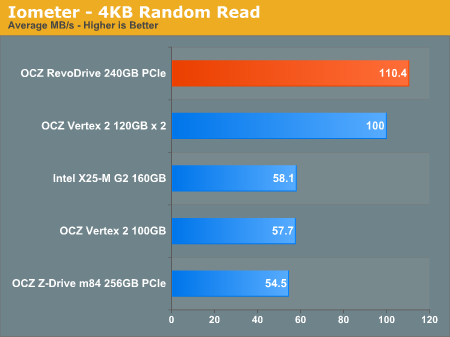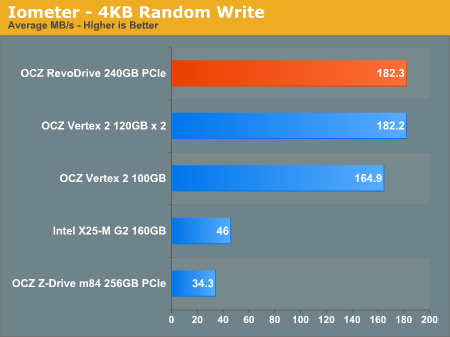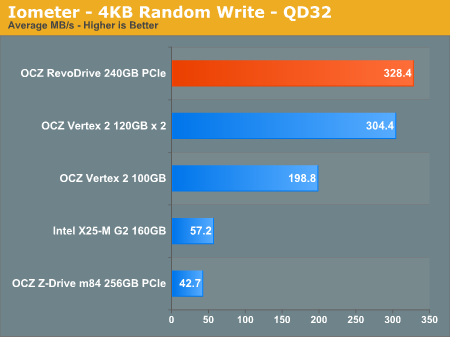OCZ's RevoDrive Preview: An Affordable PCIe SSD
by Anand Lal Shimpi on June 25, 2010 2:15 AM ESTRandom Read/Write Speed
This test reads/writes 4KB in a completely random pattern over an 8GB space of the drive to simulate the sort of random access that you'd see on an OS drive (even this is more stressful than a normal desktop user would see). I perform three concurrent IOs and run the test for 3 minutes. The results reported are in average MB/s over the entire time. All requests are 4KB aligned.

Compared to a single Vertex 2, the RevoDrive is nearly twice the performance. The Revo actually outperforms our two Vertex 2s in RAID-0 thanks to the controller on the card. This is more the exception rather than the rule however, Intel’s ICH10R is one of the fastest desktop SATA 3Gbps controllers we’ve ever seen.

At low queue depths random write performance doesn’t actually improve that much. A single Vertex 2 SSD is already running at close to peak performance here. Compared to last year’s more expensive Z-Drive m84 the performance improvement is tremendous.
Crank up the queue depth for a particularly intensive workload and you’ll see the RevoDrive separate itself from a single drive:

At over 300MB/s there’s no single SATA 3Gbps drive that could deliver this sort of performance. And honestly it’s in these high queue depth scenarios that the RevoDrive really shines. The majority of desktop users simply aren’t pushing this many IOs at a given time, but if you are the Revo won’t disappoint. A pair of Vertex 2s in RAID-0 won’t either. It all comes down to cost and preference.










62 Comments
View All Comments
Demon-Xanth - Friday, June 25, 2010 - link
That connector is called a MICTOR (not sure on the spelling). It's made to hook a logic analyzer up to and generally not useful for most people.Trisagion - Saturday, June 26, 2010 - link
Doesn't look like a MICTOR to me. A MICTOR has contacts aligned along the center, this one has contacts that are on aligned on opposite sides along the center.flgt - Saturday, June 26, 2010 - link
It looks like the Samtec version of the MICTOR. QSH series maybe. Same concept though. High speed, impedance controlled debug or board-to-board connector.Trisagion - Sunday, June 27, 2010 - link
Yes, I think you're right. Thanks!mrmike_1949 - Friday, June 25, 2010 - link
whenever you test ssd, you should still include a fast hdd as a reference point!mckirkus - Friday, June 25, 2010 - link
Seconded. A VRaptor would have been a good idea. Also, can you RAID two of these like SLI vid cards?Intel clearly has RAID figured out. I'm guessing they're going to drop their on version of this thing in Q4 with 22nm flash and blow everybody else out of the water. I also wonder what the latency is like going through all of those bridges and controllers. PCI-e is supposed to be lower latency than SATA right?
Voo - Saturday, June 26, 2010 - link
The problem with that is, that even the fastest 15k rpm SCSI drive would still be nothing more than a bar in most benchmarks, so not really that usefull and if you're interested in it you could always use bench.Though you have a point that it'd be a helpful reminder of the huge difference between HHDs and SSDs and would show that the differences even between the fastest/slowest SSDs aren't that important if compared to HDDs.
chemist1 - Friday, June 25, 2010 - link
OK, when can they shrink one of these onto an express card, so I can plug it into the PCIe slot on my early-2008 MacBook Pro (whose SATA interface is limited to 150 MB/s)?aya2work - Friday, June 25, 2010 - link
Anand,Your storage bench are very interesting and looks like most adequate storage test. Do you have any plans to make it available for other users? (for personal use)
ps: sorry for poor English
Breit - Friday, June 25, 2010 - link
Is it possible to change the stripe size on the RevoDrive's internal RAID-0 in the SI BIOS? I did a little research myself regarding stripe sizes in SSD-RAID-0's and found that a 16kb stripe size is ideal for overall performance instead of the default 64kb (at least on Intel ICH10-R). With that configured a Vertex LE RAID-0 (x2) could easily come from around 40K to 80-90K in the Vantage HDD Suite.